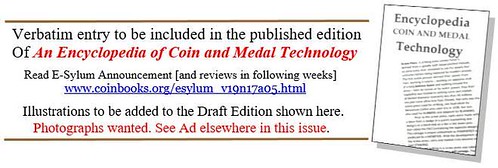
PREV ARTICLE
NEXT ARTICLE
FULL ISSUE
PREV FULL ISSUE
VOCABULARY TERM: PROVING
Dick Johnson submitted this entry from his Encyclopedia of Coin and Medal Terminology. Thanks.
-Editor

Lead proofs – also called Die trials or Lead impressions – are made while the die is still in a soft state capable of any retooling. The soft metal blank is always larger than the die and thicker than a normal blank. It can be the device alone or the completed die as shown here. Proving. Testing dies before they go into production. No matter whether a die is cut by hand or by machine, it is always useful to examine the die at each stage of production, often before it is cut any further, absolutely necessary before the die is hardened and before any items are struck from it. Thus proving occurs when the die is still capable of being improved – that is, while it is still in a soft state and further cutting can occur. Proving hand engraved dies. Hand engravers like to examine the state of the die at frequent intervals while they are working on it. This is unnecessary for CAMEO DIES, since the hand engraver is cutting in the positive, but the engraver must frequently examine a negative die. This can be done with a quick impression in very soft material – wax, clay or plasticine – a ball of such plastic material is pushed into the negative relief while the die is still locked in the vise at the engraver's bench. If the engraver cannot get as sharp of an impression by pressing the wax or clay into the die cavities by hand he would place a block of wood on top of the soft material and direct a hammer blow to the wood block. If he wanted to keep the wax or clay from sticking to the die would dust a little graphite on the steel surface first. If the wax or clay impression is not as detailed as the engraver desires he may opt for an impression in soft metal. Soft metal proving. In years past engravers would make a SPLASHER or a HOT TIN IMPRESSION, often right at their workbench. The soft metal would be heated, a small amount of melted lead, tin or pewter would be poured onto scrap paper lying on a flat surface (we still observe newspaper stuck to the back of 100-year-old splashers today). The die would be taken from the vise and pressed by hand into the molten and somewhat fluid metal. The impression – sharper than one in wax or clay – would present more distinct detail to the engraver. Handcut dies could also be proved on a small press – creating a DIE TRIAL. Large firms would have a special press reserved for this purpose – smaller firms would utilize any press not in use at the moment the engraver wanted a struck proof. A hand press could be used or one which could greatly regulate the pressure. A fairly thick blank of soft metal – always oversize – would be used with a die still in the soft stage. Thick blanks would be used not to damage the die; too much pressure, or too hard a blank, or too thin a blank could cause the die to sink or disfigure. Soft lead or tin blanks struck with low pressure could create a satisfactory die proof image at this stage. The die proof would be examined and if the die required some further work, it could, of course, still be engraved in the soft state. If the die was cut properly – with all its intended relief and with the high points intact – it would thus be acceptable. The die would then be hardened and could be placed into production. Proving machined-cut dies. In present day practice, experienced die cutting machine operators examine the die under magnification perhaps as often as hand engravers examined soft metal proofs. Each step of production must be satisfactory before going on to the next step. For machine- cut dies this would occur after each pass or each cut. While the die is locked into position in the diecutting machine a soft material impression could be taken, like the hand engraved die, in wax, clay or plasticine. This impression would be closely examined to see if all the detail was cut properly or whether another cut is required. See PANTOGRAPH. Customarily a die is removed from the diecutting machine after three separate cuttings and then a lead proof is made on the proof press. Such an impression is also called LEAD IMPRESSION or LEAD CLICHE'. Dies are always proved one at a time. They are locked in the proof press, a thick oversize blank is positioned in the press and the press is set for a very low pressure squeeze. The pressure may be increased until a satisfactory impression results. Again, the thick planchet of soft lead or tin is used to protect the soft steel die. The thick planchet acts as a cushion for the soft steel. The soft metal proof is examined and if the die is acceptable it is hardened for production. This is a stub of a much longer entry on proving. The remaining entry discusses: Lead, tin and reused metal, Die trials and Nonmetal proofs.

Wayne Homren, Editor The Numismatic Bibliomania Society is a non-profit organization promoting numismatic literature. See our web site at coinbooks.org. To submit items for publication in The E-Sylum, write to the Editor at this address: whomren@gmail.com To subscribe go to: https://my.binhost.com/lists/listinfo/esylum All Rights Reserved. NBS Home Page Contact the NBS webmaster 
|